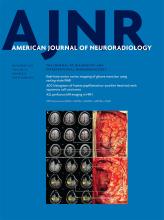Abstract
BACKGROUND AND PURPOSE: Therapeutic hypothermia is the current treatment for neonates with hypoxic-ischemic encephalopathy. It is believed to work by decreasing the brain temperature and reducing the baseline metabolism and energy demand of the brain. This study aimed to noninvasively assess brain temperature during the first month of life in neonates with hypoxic-ischemic encephalopathy treated with hypothermia.
MATERIALS AND METHODS: Neonates with hypoxic-ischemic encephalopathy treated with hypothermia and healthy neonates were enrolled prospectively. MR imaging was used to identify the presence and extent of brain injury. MR imaging multivoxel spectroscopy was used to derive brain temperatures in the basal ganglia and white matter at different time points during the first month of life. Brain temperature measurements were compared between neonates with hypoxic-ischemic encephalopathy and healthy neonates.
RESULTS: Forty-three term neonates with hypoxic-ischemic encephalopathy treated with hypothermia had a total of 74 spectroscopy scans, and 3 healthy term neonates had a total of 9 spectroscopy scans during the first month of life. Brain temperatures were lower in neonates with hypoxic-ischemic encephalopathy during hypothermia, compared with the healthy neonates (respectively, on day 1 of life: basal ganglia, 38.81°C ± 2.08°C, and white matter, 39.11°C ± 1.99°C; and on days 2–3 of life: basal ganglia, 38.25°C ± 0.91°C, and white matter, 38.54°C ± 2.79°C). However, neonates with hypoxic-ischemic encephalopathy who developed brain injury had higher brain temperatures during hypothermia (respectively, on day 1 of life: basal ganglia, 35.55°C ± 1.31°C, and white matter, 37.35°C ± 2.55°C; and on days 2–3 of life: basal ganglia, 35.20°C ± 1.15°C, and white matter, 35.44°C ± 1.90°C) compared with neonates who did not develop brain injury (respectively, on day 1 of life: basal ganglia, 34.46°C ± 1.09°C, and white matter, 33.97°C ± 1.42°C; and on days 2–3 of life: basal ganglia, 33.90°C ± 1.34°C, and white matter, 33.07°C ± 1.71°C). Also, brain temperatures tended to remain slightly higher in the neonates who developed brain injury around day 10 of life and around 1 month of age.
CONCLUSIONS: Therapeutic hypothermia using current guidelines decreased the brain temperature of neonates with hypoxic-ischemic encephalopathy during the first days of life but did not prevent an early increase of brain temperature in neonates with hypoxic-ischemic encephalopathy who developed brain injury despite this treatment.
- © 2017 by American Journal of Neuroradiology
Indicates open access to non-subscribers at www.ajnr.org












